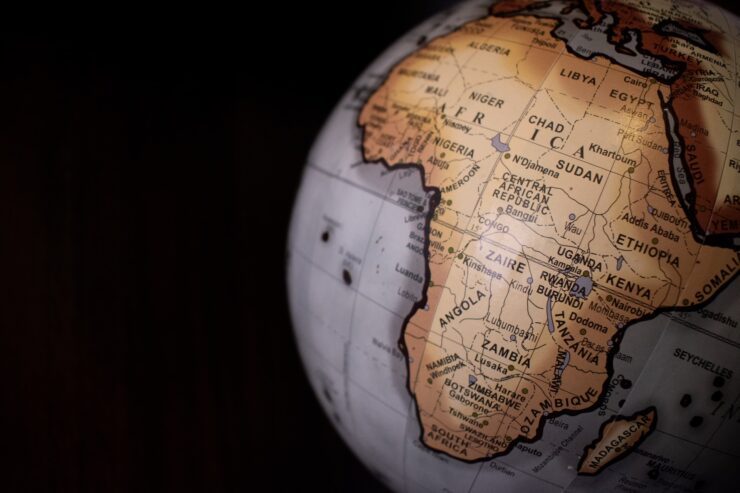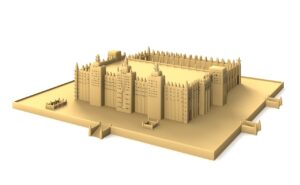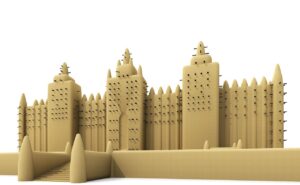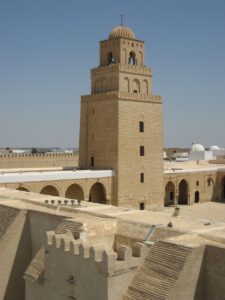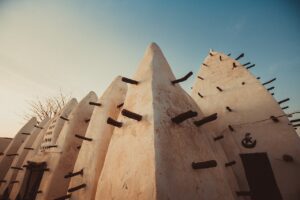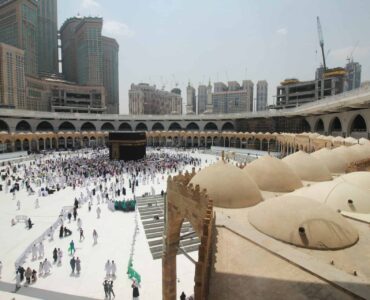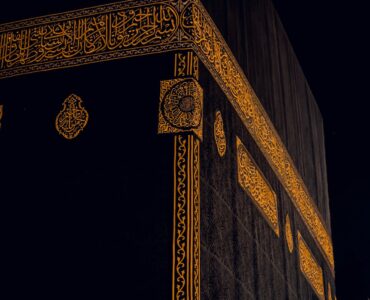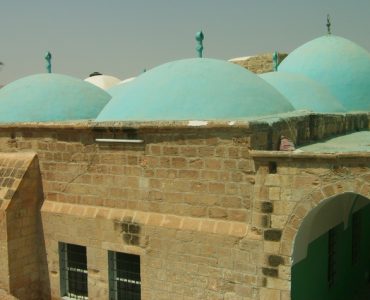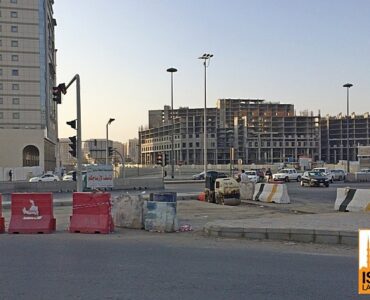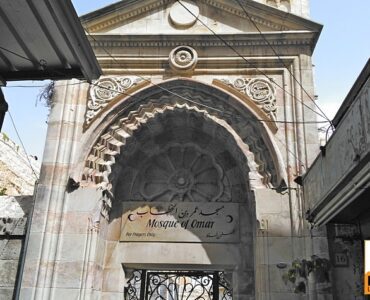Africa, a land steeped in history, culture, and biodiversity, is a continent that has witnessed the ebb and flow of civilizations for millennia.
Among the treasures hidden within the vast landscapes are the mosques that stand as silent sentinels of time, carrying with them tales of devotion, resilience, and the spread of Islam.
As we embark on a journey through history, let us unveil the stories of the oldest mosques in Africa.
When Did Islam First Reach Africa?
During the 7th century CE, during the era of the Prophet Muhammad (PBUH), the light of Islam began to cast its glow beyond the Arabian Peninsula.
In the decades following the Prophet’s (PBUH) death, Muslim traders and explorers ventured into the African continent, traversing the vast Sahara and navigating the intricate web of trading routes that connected North Africa to sub-Saharan realms.
The historical record points to a pivotal moment in the early spread of Islam in Africa: the journey of a group of Sahaba (companions of the Prophet Muhammad PBUH) who sought refuge from persecution in the Kingdom of Axum, situated in modern-day Ethiopia.
This migration of companions marked the first known interaction between Islam and Africa, predating even the famous spread of Islam into Spain.
However, it wasn’t until later centuries that Islam truly took root across the continent.
As we delve into the chronicles of Africa’s oldest mosques, we will witness the architectural marvels that testify to the enduring spiritual and cultural connections between Africa and the Islamic world.
Top 10 Oldest Mosques in Africa 2023
Mosques are more than just architectural marvels. They are embodiments of faith, witnesses to the passage of time, and vessels of culture.
Learn about Africa’s ten oldest mosques that weathered the ages.
These mosques unveil stories of devotion, conquests, and the fusion of cultures, offering a window into the intricate relationship between faith and history.
1. As-Sahaba Mosque – The Oldest Mosque in Africa
The journey through Africa’s oldest mosques takes us to the heart of Eritrea, where the As-Sahaba Mosque, also known as the mosque of the companions, stands as a testament to the enduring legacy of Islam in the continent.
Situated in the port city of Massawa, this ancient mosque boasts a history that spans more than a millennium, cementing its standing as a cornerstone of African Islamic heritage.
The mosque’s design, characterized by its simple yet elegant architecture, draws inspiration from the early Islamic architectural styles prevalent in the Arabian Peninsula.
Its significance extends beyond its architectural merits.
It serves as a beacon of faith, resilience, and unity, mirroring the values that Islam imparts.
First Mosque in Africa: Eritrea’s Claim to Fame
Nestled by the shores of the Red Sea, the As-Sahaba Mosque proudly claims the title of the first mosque in Africa. It underscores Africa’s vital role in the early days of the spread of Islam.
While the precise date of its construction is a subject of historical debate, it is widely believed to have been established during the lifetime of the Prophet Muhammad (PBUH), making it a contemporary marvel with the earliest mosques in Arabia.
When Was the First Mosque in Africa Built?
Pinpointing the exact year of the As-Sahaba Mosque’s construction is a challenge due to the scarcity of written records from that era. However, historians place its inception between the 7th and 8th centuries CE.
This time frame coincides with the initial waves of Islamic propagation, as North African traders, missionaries, and travelers carried the teachings of Islam beyond the Mediterranean shores.
2.The Great Mosque of Djenné
Nestled in Mali, the Great Mosque of Djenné stands as a remarkable fusion of architecture and cultural identity.
Its towering minarets and intricate geometric patterns echo the local style perfected over generations.
Dating back to the 13th century, though the present structure emerged in the 20th century, the mosque encapsulates history and unity.
Today, it remains an active place of worship, drawing pilgrims and visitors to its awe-inspiring presence.
The Great Mosque of Djenné Is the Largest Mud-Brick Structure in the World
The Great Mosque of Djenné boasts a distinctive adobe structure that blends architectural prowess with cultural identity.
Crafted primarily from mud bricks, straw, and wood, the mosque features soaring minarets, intricate geometric patterns, and an expansive central courtyard.
Its towering walls and grand entrances are adorned with intricate details that showcase the local craftsmanship. Its unique design has earned it a coveted spot on the UNESCO World Heritage List.
3. The Mosque of Kano: Nigeria’s Ancient Spiritual Beacon
Situated in the vibrant city of Kano, Nigeria, the Great Mosque of Kano stands as a silent testament to the country’s deep-rooted Islamic heritage. Its foundations were built as far back as the 15th century.
As the oldest mosque in the country, it carries an immense spiritual weight, providing solace, guidance, and communal connection for generations of worshippers.
The mosque’s graceful minarets, intricate carvings, and spacious courtyard reveal a harmony between aesthetics and functionality. From the call to prayer echoing through its corridors to the architectural details that whisper stories of centuries past, this mosque invites us to honor the legacy of those who have prayed within its walls and to celebrate the enduring vitality of Nigeria’s Islamic identity.
4. Al-Nagashi Mosque: Ethiopia’s Hidden Jewel of Faith
Nestled within the ancient city of Aksum in Ethiopia, Al-Nagashi mosque holds a unique place in history as one of Ethiopia’s oldest and most enduring symbols of Islamic heritage.
It is believed to have been built in the 7th century and named after the term “Al-Nagashi,” which refers to the Muslim community of Ethiopian descent.
The architecture of the Al-Nagashi Mosque is a blend of simple elegance and cultural resonance with whitewashed walls and graceful minaret. Beyond its visual allure, the mosque holds profound spiritual significance for both the local Muslim community and visitors from afar.
It serves as a spiritual sanctuary, a space for reflection, and a symbol of the rich tapestry of Ethiopia’s diverse religious heritage.
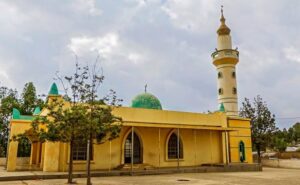

5. Kizimkazi Mosque – One of the Oldest Mosques in East Africa
Kizimkazi is a historic mosque located in the village of Kizimkazi. Thought to be one of the oldest mosques in East Africa, its foundation is attributed to the early days of Islam’s presence in the region, dating back to the 12th century.
Beyond its religious significance, the mosque holds a place of reverence due to its role in the history of Swahili civilization and the interactions between African, Arab, and Persian cultures.
The mosque’s architecture embodies the unique cultural influences that characterize Zanzibar’s history. Its simple, coral-stone structure is adorned with intricately carved wooden decorations, reflecting the region’s maritime heritage and the skillful craftsmanship that defines Swahili architecture.
The mosque’s whitewashed walls contrast beautifully with the azure waters of the Indian Ocean, creating a breathtaking panorama that merges the spiritual and the natural worlds.
6. Qayrawan Mosque – One of the Oldest Mosques in North Africa
The Qayrawan Mosque, also known as the Great Mosque of Kairouan, is widely considered to be the oldest mosque in North Africa.
Located in Kairouan, Tunisia, this mosque is significant in Islamic history and architecture.
It was built in 670 CE and has since served as the region’s spiritual and cultural center.
The mosque’s intricate design, with its impressive prayer hall, minaret, and courtyard, reflects the early architectural styles of Islamic North Africa and has influenced mosque design in the region for centuries.
The Qayrawan Mosque’s historical and architectural importance has earned it recognition as a UNESCO World Heritage Site.
7. Masjid al-Qiblatayn – Tracing History in Somaliland
In the northwestern Awdal region of Somalia, the historic town of Zeila cradles a mosque that whispers the tales of centuries past—the Masjid al-Qiblatayn, also known as Labo-qibla Mosque.
This mosque stands as a testament to the rich Islamic heritage of the region, intertwining faith, history, and architecture in its storied walls.
Masjid al-Qiblatayn carries a weighty history that dates back to the earliest days of Islam. Its name, which translates to “The Mosque of the Two Qiblas,” alludes to a pivotal moment when the direction of prayer (qibla) was changed from Jerusalem to Mecca.
The mosque’s significance reaches beyond its local setting, resonating with the broader narrative of Islam’s evolution.
The mosque’s architecture, though simple in design, echoes the aesthetics of early Islamic mosques with a single minaret and understated elegance.
This unassuming beauty is a testament to the devotion and craftsmanship of those who built it, and it evokes a sense of timelessness that transports visitors to an era of reverence and simplicity.
8. Arba’a Rukun Mosque: A Pillar of Faith and History
Arba’a Rukun Mosque, whose name translates to “Mosque of the Four Pillars,” carries a deep-rooted significance that extends beyond its physical structure.
It was established during the early Islamic presence in the heart of Harar, Ethiopia, built back in the 13th century.
The mosque’s pillars not only support its architecture but also symbolize the unity of the Muslim community in their devotion to prayer and faith.
The architecture of the mosque combines Islamic and local elements, resulting in a beautiful and cohesive space.
Its whitewashed walls, intricate carvings, and graceful archways reflect the elegance of Islamic design principles while embracing the cultural context of Harar.
Arba’a Rukun Mosque is not only a spiritual center but also a cultural haven. It has played a pivotal role in developing Harari culture and preserving the city’s historical identity.
9. Chinguetti Mosque: A Sahara Jewel of Spiritual Heritage
The Chinguetti Mosque, often called the “City of Libraries,” rises like a golden mirage in the heart of the Mauritanian Sahara. As one of the most iconic landmarks of Chinguetti and a UNESCO World Heritage Site, this mosque traces its origins back to the 13th century.
Founded during the zenith of Saharan trade routes, this mosque stood at the crossroads of cultural exchanges and intellectual endeavors.
As a center of learning and faith, it became a beacon for travelers, scholars, and pilgrims traversing the vast desert landscape.
The architecture tells a tale of survival against the relentless desert sands. Its adobe walls reflect the practical brilliance of Saharan builders.
This architectural marvel not only blends seamlessly with the arid environment but also stands as a living example of human adaptation and ingenuity.
10. Larabanga Mosque: An Architectural Marvel of Spiritual Significance
In the remote town of Larabanga, nestled within the Northern Region of Ghana, a sacred jewel of architecture and faith graces the landscape—the Larabanga Mosque.
Known as one of the oldest mosques in West Africa, Larabanga was built in the 15th century, tracing its roots to the early days of Islamic influence in the region.
Founded during the trans-Saharan trade era, the mosque’s Sahelian style architecture is characterized by its adobe construction, graceful minarets, and intricate designs. The mosque’s exterior, with its warm earth tones, harmoniously blends with the surrounding landscape.
The minaret, reminiscent of traditional Sudano-Sahelian architecture, adds a touch of elegance and reverence to the structure.
Beyond its architectural significance, the Larabanga Mosque is a cultural haven and a spiritual center that unites the community. It continues to serve as a place of worship, drawing worshippers and visitors alike.
The mosque’s history is interwoven with local traditions, folklore, and stories passed down through generations. As a touchstone of identity, it anchors Larabanga’s sense of place and belonging.
Summary – Oldest Mosques in Africa
From the shores of Massawa in Eritrea, where the As-Sahaba Mosque proudly claims its place as the world’s first, to the tranquil oases of the Sahara, where the Chinguetti Mosque whispers tales of Saharan civilizations, mosques around Africa carry the weight of centuries, bridging eras and cultures.
The Great Mosque of Djenné, rising majestically from Mali’s landscape, showcases the craftsmanship of a people steeped in tradition. The Qayrawan Mosque in Tunisia carries the weight of centuries.
As we traverse Africa’s map, we encounter the cultural nexus of the Arba’a Rukun Mosque in Ethiopia and the architectural marvel of the Larabanga Mosque in Ghana.
We find solace in the Sahelian splendor of the Larabanga Mosque. The Masjid al-Qiblatayn in Zeila, Somalia, resonates with a profound shift in Islamic history, while the Al-Nagashi Mosque of Ethiopia’s Aksum tells tales of crossroads between cultures.
As we gaze upon these ancient sanctuaries, remember that they are more than structures; they are beacons of devotion, knowledge, and human aspiration.
The echoes of prayers, the whispers of scholars, and the footsteps of countless believers reverberate within their walls, guiding us to reflect on the interplay between faith, history, and the human journey.

